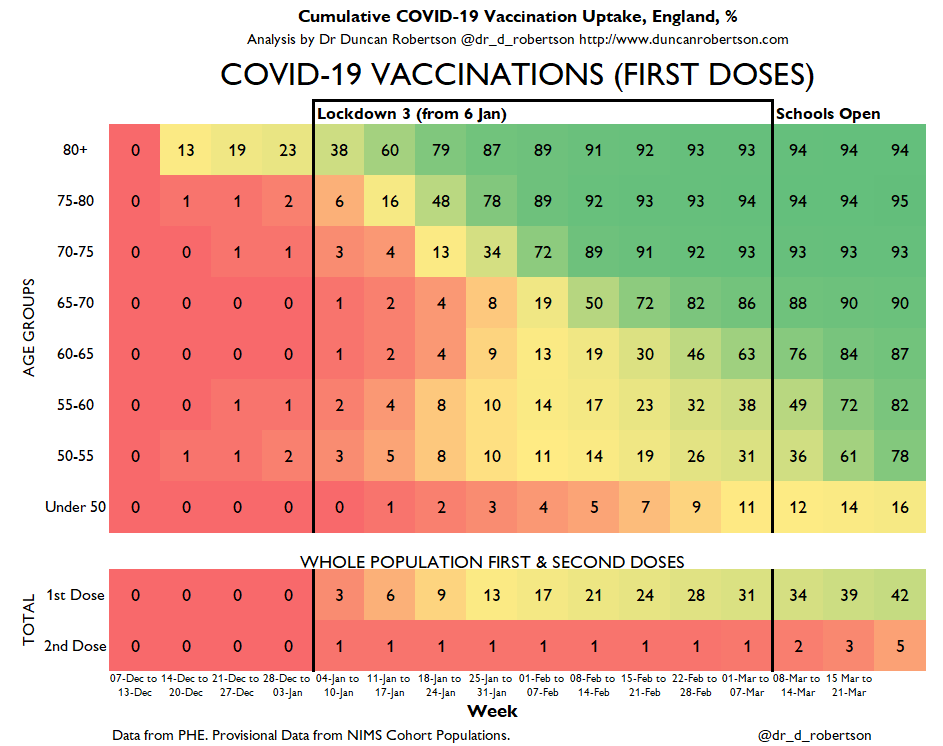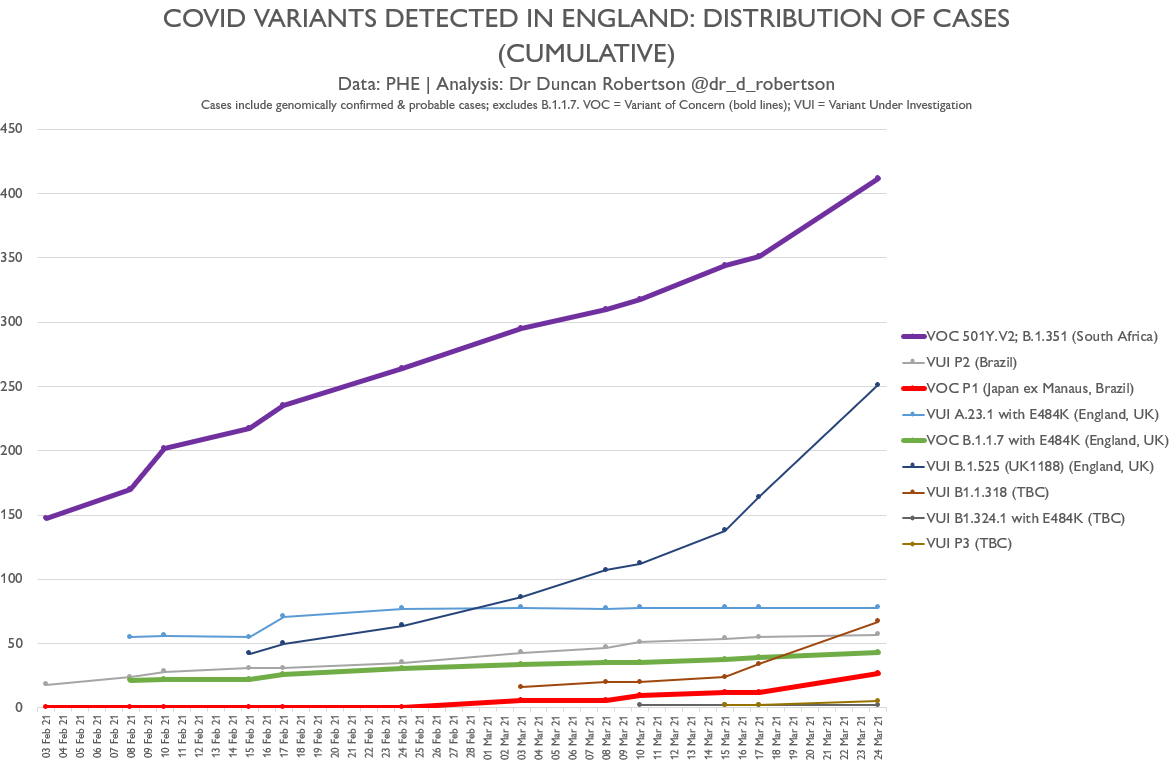
A decision will shortly be made about whether we should move to Step 2 of the Roadmap for unlocking
The premise of moving to the next step is that it should be led by:
- data not dates; & be
- irreversible
A thread with my thoughts using the latest data.


The premise of moving to the next step is that it should be led by:
- data not dates; & be
- irreversible
A thread with my thoughts using the latest data.
https://twitter.com/Dr_D_Robertson/status/1363881367197671425


The Roadmap tests are:
1. The vaccine deployment programme continues successfully
2. Evidence shows vaccines are sufficiently effective in reducing hospitalisations and deaths in those vaccinated
...
1. The vaccine deployment programme continues successfully
2. Evidence shows vaccines are sufficiently effective in reducing hospitalisations and deaths in those vaccinated
...

3. Infection rates do not risk a surge in hospitalisations which would put unsustainable pressure on the NHS
4. Our assessment of the risks is not fundamentally changed by new Variants of Concern
4. Our assessment of the risks is not fundamentally changed by new Variants of Concern

Cases data is unreliable due to the mixture of LFD and PCR testing. Given this caveat, the detected cases data shows increases in the 10-19 age group but decreases in all other age groups.
This is expected as increased interaction following children returning to school.
This is expected as increased interaction following children returning to school.

Cases by themselves are not one of the four Roadmap tests.
I anticipate that cases will rise in the 20-40 year old populations in the weeks to come as cases spread to parents and carers.
Hopefully LFD testing for school children and households will mitigate some of this effect.
I anticipate that cases will rise in the 20-40 year old populations in the weeks to come as cases spread to parents and carers.
Hopefully LFD testing for school children and households will mitigate some of this effect.
Positivity (number of people testing positive divided by the number of people taking tests) is very low in 10-19 year olds as there are millions of LFD tests taken.
However, 5-9 year olds do not (generally) take LFD tests, so a fall in positivity here is encouraging.

However, 5-9 year olds do not (generally) take LFD tests, so a fall in positivity here is encouraging.


Looking at Roadmap Test 3:
3. Infection rates do not risk a surge in hospitalisations which would put unsustainable pressure on the NHS
we can use hospitalization and ICU admissions data.
Hospitalizations falling in all age groups (except for under 5s - small numbers admitted)
3. Infection rates do not risk a surge in hospitalisations which would put unsustainable pressure on the NHS
we can use hospitalization and ICU admissions data.
Hospitalizations falling in all age groups (except for under 5s - small numbers admitted)

Looking at Roadmap Test 2:
2. Evidence shows vaccines are sufficiently effective in reducing hospitalisations and deaths in those vaccinated
ICU admissions are relatively low. Note that '0' does not mean no admissions, just 0 per 100,000 when rounded to the nearest whole number
2. Evidence shows vaccines are sufficiently effective in reducing hospitalisations and deaths in those vaccinated
ICU admissions are relatively low. Note that '0' does not mean no admissions, just 0 per 100,000 when rounded to the nearest whole number

Looking at Roadmap Test 1:
1. The vaccine deployment programme continues successfully
we can look at the roll out of vaccines.
Still very encouraging - not 100% coverage, which means many people still vulnerable. Mainly first doses.
1. The vaccine deployment programme continues successfully
we can look at the roll out of vaccines.
Still very encouraging - not 100% coverage, which means many people still vulnerable. Mainly first doses.

And finally, Roadmap Test 4
4. Our assessment of the risks is not fundamentally changed by new Variants of Concern
This is the test that in my opinion causes the greatest risk.
Cases are dominated by the B.1.1.7 variant. Note log scale and *cumulative* chart.
4. Our assessment of the risks is not fundamentally changed by new Variants of Concern
This is the test that in my opinion causes the greatest risk.
Cases are dominated by the B.1.1.7 variant. Note log scale and *cumulative* chart.

Stripping out B.1.1.7 and looking at this *cumulative* chart, we still see increases in the B.1.351 (South Africa, purple line) variant and the P1 (Manaus, Brazil, red line) Variants of Concern.
Numbers will have been biased by surge testing, but increasing numbers shows a risk
Numbers will have been biased by surge testing, but increasing numbers shows a risk

Going back to the Roadmap:
Tests 1-3 are generally positive but there remains a risk
Test 4 (variants) is where there is potential high risk.
However, the constraint that the steps should be 'irreversible' means that ministers should be *very* aware of the risks they are taking
Tests 1-3 are generally positive but there remains a risk
Test 4 (variants) is where there is potential high risk.
However, the constraint that the steps should be 'irreversible' means that ministers should be *very* aware of the risks they are taking
We remain in a battle between the Virus, Vaccines, and Variants.
Opening up further will mean that groups not previously in contact will mix meaning new chains of infection
*When* to open up remains a political decision.
As ever, advisers advise and ministers decide.

Opening up further will mean that groups not previously in contact will mix meaning new chains of infection
*When* to open up remains a political decision.
As ever, advisers advise and ministers decide.


• • •
Missing some Tweet in this thread? You can try to
force a refresh










